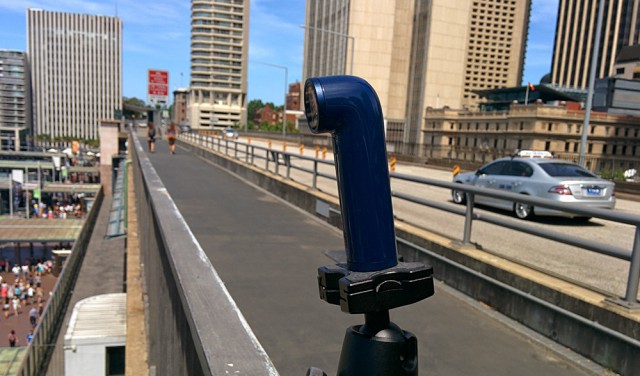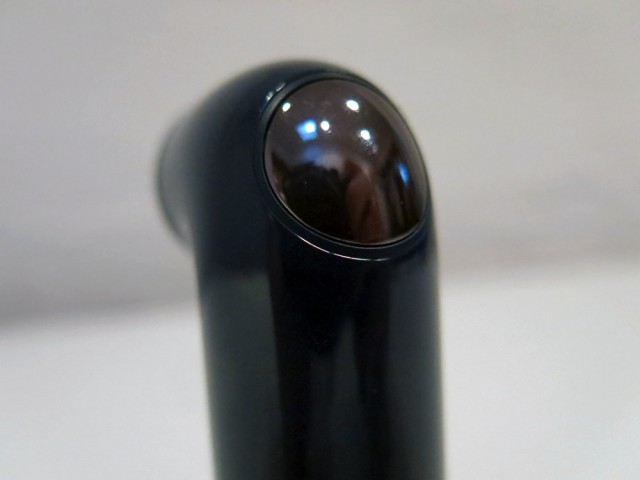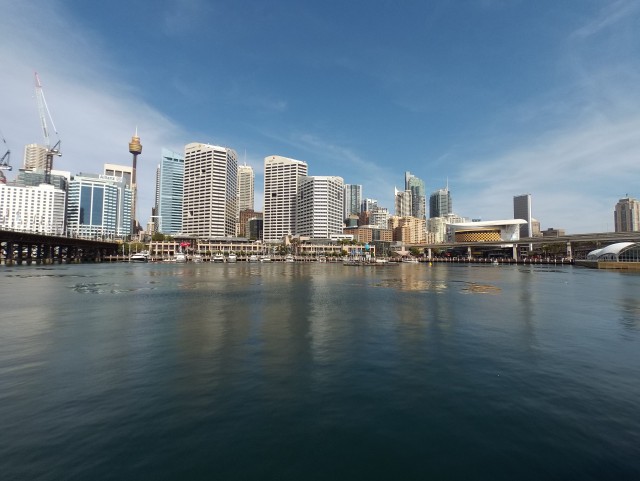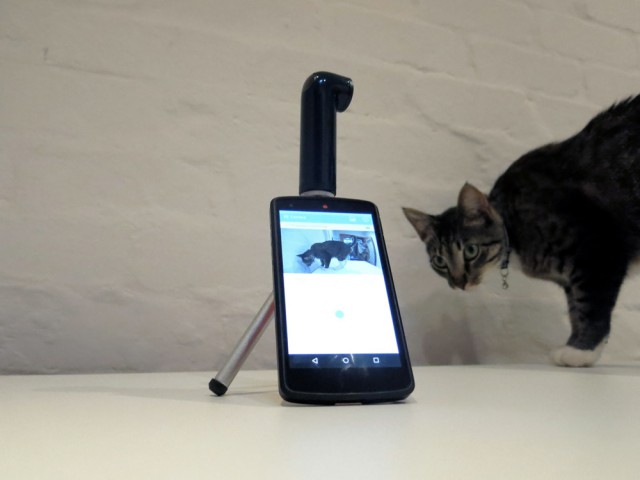
HTC announced the tiny, portable and decidedly odd-shaped Re camera at its October Double Exposure event in New York. The RE represents the company’s first step away from its core smartphone product line in a long time, a move to market a more mainstream consumer electronics product.
For today’s Australian release of the Re, we’ve been putting HTC’s diminutive camera through its paces around Sydney. After a couple of weeks with the camera it’s safe to say HTC might have a fight on its hands to get this one back.

The RE is smaller than it looks. Stood upright, it’s shorter than a cup of coffee, and its cross-section is about the size of a dollar coin. Your first instinct when you see it is to pick it up and hold it – and you won’t be disappointed. The distinctive pipe shape is glossy smooth plastic, making it easy to grip in any number of ways. It’s friendly, and rewards being handled. While the “pistol grip” is a pretty easy default, you’ll find a grip that’s comfortable very quickly for any situation you’re in.
The shape serves another, perhaps more accidental purpose. People noticed it when I took it out in public, and it became a talking point. While they often joked about the shape (it looks roughly like an asthma puffer, and the test unit’s blue colour didn’t help that comparison) it’s definitely a conversation starter. One busker at Circular Quay joked that he thought I was going to zap him, a la Men in Black. These are all good things for HTC – they’ll want people to talk about their product. Some of the brighter colours will probably stand out more in a crowd, too.
Once you tell someone that the weird little pipe you’re holding is actually a 16MP camera with a Sony sensor behind an ultra wide-angle lens, you’ll get their attention. Add that it’s waterproof and can shoot 1080p video or 720p slow motion video, and it doesn’t matter how silly they think it looks – they’ll want one, and the RE’s modest $250 asking price will very likely find it under a number of Christmas trees this year.
So what is the RE camera, when it all comes down to it? Unlike my first impressions of the device after launch, HTC says it doesn’t want to take on the GoPro’s of the world. You can certainly use the RE in that way (there’s head mounts, bike mounts and more accessories available), but the company really intends the RE to be more of a fun consumer electronics device. You can use it to shoot the world around you, you don’t have to line up your photos perfectly (you can crop and straighten 16MP images just fine), and the size and shape means you can pull off some interesting angles you might not have tried before.
Speaking of angles, the RE has a lot of them – over 140 degrees, in fact. That’s an ultra wide angle lens, which produces a fisheye effect on the photos it takes. You can straighten this up in software, although that can have a few undesirable results if your subject isn’t in the dead centre of the frame. You can also disable the ultra wide angle shooting, which leaves you with a more natural looking – albeit smaller – image. I found it a little easier to shoot with ultra wide angles off, but that depended entirely on what I was shooting.

There’s a shutter button on the back that shoots 16MP stills when pressed and shoots 1080p video with a long press. The secondary button on the front puts video shooting into slow motion mode (720p @ 120fps), although this is a setting you need to change before you start shooting. The unit beeps and bleeps happily through normal operation, but you can change this (your options are Loud, Soft and Off).

Underneath, there’s a surprising amount going on. Firstly there’s the standard tripod mount – you can attach the RE to anything that’s got a standard tripod head, which means the little tripods your relatives keep giving you for Christmas are suddenly useful. I had it attached to a Joby Gorillapod you can see at the top of this post, and there’s countless other things you can attach it to. Flanking the tripod mount is the Micro SD slot, sealed with a gasket to make it waterproof, and the Micro USB port… which has no gasket, but is most certainly waterproof.
The RE’s IP rated for submersion in 1 meter of water for 30 minutes. It’ll survive a swim in the pool, but anything more drastic and you’ll need to beef up that IP rating. Fortunately, HTC’s got you covered with an additional cap for the base of the camera that screws into the tripod mount and lets you go a little deeper for longer. It’s rated for fresh water though, so you’ll still need to watch out near salt water.

You do need to be a little bit careful when shooting stills – it doesn’t always shoot exactly when you ask it to, and sometimes there’s a half second or so between pressing the button and the camera shooting. The handheld nature of the RE means you’ll probably tend to wave it around a bit, so you’ll want to hold it steady and watch for the brief red LED flash in the shutter button to let you know the shot’s been taken. In a really bright environment, you might not always be able to see the LED, and you’ll just have to trust the shot’s been taken.
If you’re patient, you can pull off some fantastic shots. If you’re not, you might find some disappointing and blurry shots on your Micro SD card. Your patience can be rewarded with shots like this, which I think might be the best picture I pulled off with the Re:

The RE is really good at shooting still subjects – distance, buildings, landscapes – which is a bit ironic considering the “action camera” basket most of the media’s put it into. The reality is that moving subjects that are close to the camera aren’t always captured perfectly in stills, so you’ll need to get a feel for what you can and can’t shoot with it. This is no different to knowing what your DSLR is capable of and the environments in which you can use different settings.
The other advantage offered by the weird form factor is one shared with Sony’s QX “lens-style” cameras from last year – manoeuvrability. You can get the RE camera into places that your smartphone can’t go – crevices, between bars and generally into small places. Once there you can stand it up, point it in the right direction and use the remote shutter function on your phone to snap the pic. I was even able to use it to shoot the inside of my cat carrier.
When the RE does it’s thing, it does it well. Sometimes though, you might end up with a shot that’s a little overexposed and sometimes you might get some motion blur. It’s dependent on your subject and how steady you can hold the camera.

While you can capture images in low light with the Re, it doesn’t always do the best job. Low light images tend to have a bit more noise in them than you might be comfortable with. In general, I was “re”ally happy with the results (sorry) although I ended up shooting many scenes twice just to be sure I’d gotten it.
Tis the season for it too, so I’ve also been taking a few shots of Christmas trees around Sydney with the Re. These photos were modified by Snapseed before uploading to Instagram though – a perfectly valid way to preprocess photos from the RE before sharing them onto social media. It also shows that square cropping a photo from the RE roughly around the centre of it delivers a far more standard-ish picture, without the fisheye effect at the extreme wide angle edges.
Video, fast and slow
You can also shoot 1080p video with the Re. You’ll end up with a fair fisheye effect on the video, and the effect if you’re moving around is somewhat like a roving security camera (or perhaps the monster’s-eye-view on Doctor Who). The fisheye effect means objects that aren’t dead centre of your frame (ie, the camera pointing right at it) tend to be quite distorted, and out of focus. Fisheye videos are pretty popular with the action sports segment, and I expect they’ll take to the RE quite happily.
Slow motion videos in general though are pretty fun with the right subjects. Animals and weather are some of the best subjects because you’ll pick up subtle movements you didn’t expect. For example, you can see here pretty much the exact moment that the pigeons decided I’d gotten too close.
With Sydney’s recent spate of storms, I’ve also tried to capture some slow-mo lightning, with varying results. Shot off my balcony at almost midnight, lightning was probably a little too much for the RE’s sensor – you can see what looks like scan lines in the video, some video artifacting and more. Even in slow motion the lightning can only be seen for a frame or two. Note that this is a composite video, so there’s a few camera position changes.
I suspect if I’d had a higher vantage point and the lightning wasn’t passing directly overhead, there’d be some better results. Still, it’s impressive that you can get results like the photos above AND this slow-mo lightning out of the same device.
Apptastic
The RE connects to your phone via an app, available from Google Play and on Apple’s App Store. On Android, it connects with Bluetooth and Wi-fi Direct, while on iOS you need to connect your phone or tablet manually to the hotspot provided by the Re.
In truth, it takes a little longer to establish its connection than I really wanted it to, and sometimes the connection was a little wonky making me a little distrustful of it.
Once it is connected though, you get a timeline view of photos on the Re, grouped by day in a grid alignment. You can swipe through the photos and videos like any other gallery app. There’s a slight delay as it loads the images from the RE in realtime. You can also bulk select items to copy to your phone or delete from the Re.
The first image for each day is a prompt to create a Zoe movie – the idea is that you can select the best images and turn them into a motion video to capture the highlights of the day, although you can also switch this behaviour off if you’d just like the timeline to function as a standard view of images.
You can tell the RE to back up photos to your phone, and other options like Google Drive and Dropbox will be coming soon.
When you copy photos and videos to your phone, they’ll end up in a “Re” folder. The photos don’t always end up in the right chronological order though, so it’s more difficult to attach them to posts on some social networking services than others – depending on the way their photo selection tools work. It looks like this might be an issue with the way some of the EXIF data is stored in the images, so it can probably be fixed with a firmware update.
The app can also provide you with a realtime picture of what the RE is seeing, which will help you line your shots up a little more and puts control over shutter release on your phone – handy where pressing the shutter on the RE might move the camera. In portrait mode, the viewfinder display is pretty small but in landscape it’s full screen.
It’d be nice to see some additions to the live viewfinder like a grid overlay to more precisely line up shots, and toggling shooting options like the ultra-wide viewfinder or slow-mo options from this screen.
Time Lapse
Using the app (but only by using the app) you can also pull off time lapse videos. You can choose the number of frames to shoot and the playback speed of the video, although for some reason you need to set these before you start.
While shooting the time lapse videos, you’ll hear the shutter sound every time a frame is snapped – it’s good thing you can turn the sounds off.
It turns out, time lapse videos are actually just stored as a series of JPG files on the Micro SD card which the RE app assembles into a video when you download it to your phone. You can put the Micro SD card into a computer access individual frames and remove them if you like, or use your own software to assemble the time lapse. At that point you can decide for yourself the frame rate and duration, which is why it’s a little puzzling to have to set this upfront.
The RE has been a lot of fun to use. It fits next to my wallet in my pocket – another advantage to its shape – and it’s easier to take out the RE to snap a picture than it is my phone. It lacks features like HDR shooting and of course there’s no OIS so my Nexus 5 will probably still take a better shot, but this doesn’t diminish from the convenience and fun that can be had with it.
While we haven’t had a chance to check out any of the accessories yet, there’s a good bet that you’ll find a mount available for the RE for whatever you want. Personally, it’s the bike and the head mounts that I’m most interested in for my daily commute to and from work.
HTC’s timed the launch of the RE well for the Australian market. It’s fun, simple, produces some great results, and it’s compatible with the majority of the smartphone market. The RE will be a great impulse gift for someone this Christmas, and if you like to experiment and dabble with photography, it should find its way onto your own Christmas list.





























Need a small waterproof camera for fishing in Kiribati next week, this review made me buy a HTC Re. Gonna be gooood!
Great review, very detailed. How did real world battery performance turn out?
Polaroid Cube will give RE a run for it’s money.
HD 1080p video
6MP camera
124° wide-angle lens
Splash-resistant up to 2m
Records up to 90 minutes
35mm x 35mm
MicroSD up to 32GB
But can you conveniently carry it around in your pocket? I think the size of this thing is the killer feature.
One thing I’d like to know is what the battery life is like?